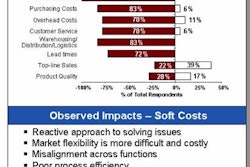Southfield, MI — September 8, 2008 — Lower industry volumes and the massive decline in truck and SUV sales have put as many as one-third of automotive suppliers in North America at risk of bankruptcy, according to the "Summer 2008 Automotive Industry Review" prepared by Grant Thornton Corporate Advisory and Restructuring Services.
At the same time, Grant Thornton believes that bankruptcy concerns for the Detroit Three domestic automakers are overblown, despite recent credit downgrades by the major debt rating agencies and news reports this week that the major U.S. auto companies will seek federal government loans to shore up their operations while they restructure.
"The magnitude of the decline in truck and SUV sales can be captured in two key events likely to unfold this year: the Toyota Camry ending the Ford F-Series' 26-year run as the best-selling vehicle line and Honda vaulting past truck-dependent Chrysler to become the number three automaker by annual U.S. sales," said Kimberly Rodriguez, principal of Grant Thornton Advisory Services Automotive Platform.
The report said at-risk suppliers feature one or more of the following qualities:
"The decline in industry volumes and the shift to more fuel-efficient vehicles is creating a massive ripple effect in the supply chain," said Rodriguez. "The full impact of very low truck and SUV production in the second half of the year and any new production cutbacks this fall — something we believe is likely — will only make supplier cash flow problems more difficult to manage.
"It's not just the suppliers producing lift gates, transfer cases and other truck-only parts that are at risk, but also all those relying on truck volumes for survival, including companies producing chassis systems, NVH systems, driveline and drivetrain components, stampings, and a host of others," she added.
Chapter 11 Risk Low for OEMs
While bankruptcy is a real possibility for many suppliers, Rodriguez believes the risk of an OEM filing for bankruptcy is remote, especially for General Motors and Ford, despite asset impairments, growing losses from continuing operations in the United States and massive restructuring charges.
"Ford and GM are not going to file for bankruptcy," said Rodriguez. "It would start a domino effect of bankruptcies throughout the supply base and it would tank consumer confidence in their brands, even in markets like Asia, Europe and South America where they are profitable and growing. The bankruptcy process carries too many risks, so they're going to have to look at all financing options available, including government loans, joint ventures, foreign investment and other financing in capital markets. The target will be to have enough cash to get them to 2010, when their product lines will be more in line with customer demands."
Chrysler also is an unlikely candidate for bankruptcy, but for different reasons: the value of its assets like assembly plants, its parts and service business and its retail network. "It's the appropriate time for companies like SAIC (Shanghai Automotive Industry Corp.), Tata, Renault and others who have been holding back on capital, to establish footholds on U.S. soil, either through acquisitions or greenfield investments," Rodriquez said.
Double-digit Declines in Dealer Ranks Possible
At the local level, the auto industry crisis will play out at thousands of dealerships across the country, according to the "Automotive Industry Review."
Lower throughput, higher expenses and declining margins have plagued many dealerships over the last several years, especially those selling domestic brands. Now, with annual industry volumes plummeting from the 16- to 17-million unit range of 1999-2007 to about 14.5 million units in 2008, many stores are no longer viable.
According to Grant Thornton's analysis, 2,736 dealerships would need to close just to maintain sales per dealer at last year's level of 747 units.
"The total number of U.S. light vehicle dealerships has been declining since 2003, but for the domestics, the declines have not kept pace with their sales and share declines," said Rodriquez. "Without consolidation, the average dealership will sell 81 fewer units this year than the 10-year average. Stores already struggling may not make it and operators should be open to consolidation opportunities."
The full Automotive Industry Review can be viewed at http://www.grantthornton.com/automotive.
At the same time, Grant Thornton believes that bankruptcy concerns for the Detroit Three domestic automakers are overblown, despite recent credit downgrades by the major debt rating agencies and news reports this week that the major U.S. auto companies will seek federal government loans to shore up their operations while they restructure.
"The magnitude of the decline in truck and SUV sales can be captured in two key events likely to unfold this year: the Toyota Camry ending the Ford F-Series' 26-year run as the best-selling vehicle line and Honda vaulting past truck-dependent Chrysler to become the number three automaker by annual U.S. sales," said Kimberly Rodriguez, principal of Grant Thornton Advisory Services Automotive Platform.
The report said at-risk suppliers feature one or more of the following qualities:
- Heavily reliant on large SUV and truck volumes;
- Located only in North America;
- Concentrated on domestic OEM sales;
- Have a significantly large SUV and truck platform part sourcing;
- Exposed to increases in raw materials costs without ability to pass on to customer.
"The decline in industry volumes and the shift to more fuel-efficient vehicles is creating a massive ripple effect in the supply chain," said Rodriguez. "The full impact of very low truck and SUV production in the second half of the year and any new production cutbacks this fall — something we believe is likely — will only make supplier cash flow problems more difficult to manage.
"It's not just the suppliers producing lift gates, transfer cases and other truck-only parts that are at risk, but also all those relying on truck volumes for survival, including companies producing chassis systems, NVH systems, driveline and drivetrain components, stampings, and a host of others," she added.
Chapter 11 Risk Low for OEMs
While bankruptcy is a real possibility for many suppliers, Rodriguez believes the risk of an OEM filing for bankruptcy is remote, especially for General Motors and Ford, despite asset impairments, growing losses from continuing operations in the United States and massive restructuring charges.
"Ford and GM are not going to file for bankruptcy," said Rodriguez. "It would start a domino effect of bankruptcies throughout the supply base and it would tank consumer confidence in their brands, even in markets like Asia, Europe and South America where they are profitable and growing. The bankruptcy process carries too many risks, so they're going to have to look at all financing options available, including government loans, joint ventures, foreign investment and other financing in capital markets. The target will be to have enough cash to get them to 2010, when their product lines will be more in line with customer demands."
Chrysler also is an unlikely candidate for bankruptcy, but for different reasons: the value of its assets like assembly plants, its parts and service business and its retail network. "It's the appropriate time for companies like SAIC (Shanghai Automotive Industry Corp.), Tata, Renault and others who have been holding back on capital, to establish footholds on U.S. soil, either through acquisitions or greenfield investments," Rodriquez said.
Double-digit Declines in Dealer Ranks Possible
At the local level, the auto industry crisis will play out at thousands of dealerships across the country, according to the "Automotive Industry Review."
Lower throughput, higher expenses and declining margins have plagued many dealerships over the last several years, especially those selling domestic brands. Now, with annual industry volumes plummeting from the 16- to 17-million unit range of 1999-2007 to about 14.5 million units in 2008, many stores are no longer viable.
According to Grant Thornton's analysis, 2,736 dealerships would need to close just to maintain sales per dealer at last year's level of 747 units.
"The total number of U.S. light vehicle dealerships has been declining since 2003, but for the domestics, the declines have not kept pace with their sales and share declines," said Rodriquez. "Without consolidation, the average dealership will sell 81 fewer units this year than the 10-year average. Stores already struggling may not make it and operators should be open to consolidation opportunities."
The full Automotive Industry Review can be viewed at http://www.grantthornton.com/automotive.












